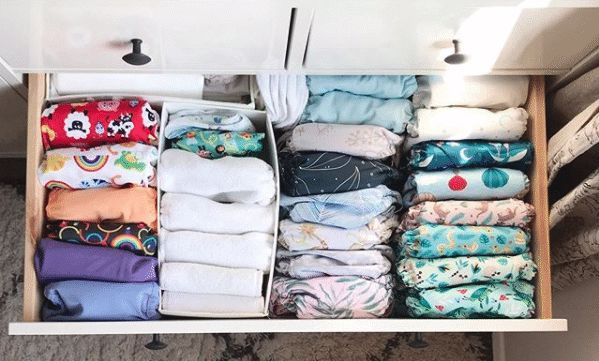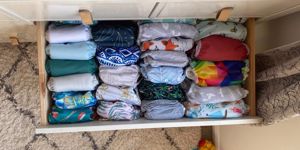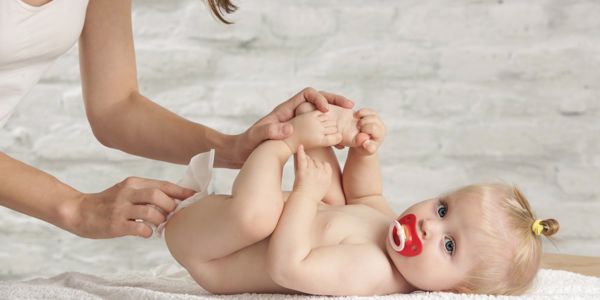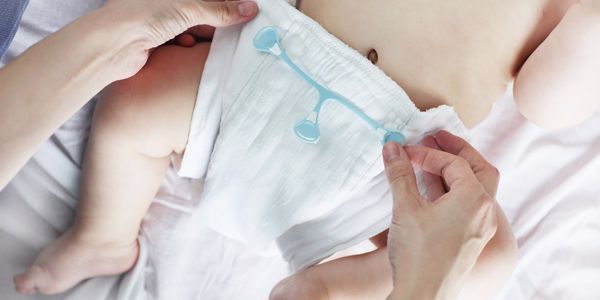I would be lying if I said that the reason I started using cloth nappies was that I was worried about the environment, at first anyway. I had used them in the past, working in childcare, and had found them to be an utter ballache so I didn’t give them more than a passing thought when I was pregnant. I had researched brands and stocked up on first size nappies in preparation for baby’s arrival and bulk ordered wet wipes on Amazon. I had heard about a scheme run by the Local Authority that sent free cloth nappies, and I signed up thinking it would be a
good idea to have them at home in case of emergency or if we ran out of nappies late on a Sunday evening.
When Cassius was a few weeks old he developed a very sore bottom. Newborns require near-constant nappy changes and I thought the hourly wiping with the overpriced, chemical-free, ultra-gentle wet wipes was taking its toll and the absorbent gel in the nappies was irritating his skin. We decided to use the cloth nappies we had, just until the rash cleared up. When we switched back to the disposables, the rash came back and after trialling a more expensive brand, we realised that maybe the nappies were the culprit. I spent hours online looking into cloth reusable nappies and ordered a few to try. The more I read, the more I understood how terrible for the environment disposable nappies are. Even eco-friendly, compostable nappies are not truly biodegradable and every single disposable nappy ever made is still on the planet because they can take hundreds of years for the plastic to break down.
[Read more: Nappy Rash Symptoms and Solutions]

I wasn’t totally unaware of the climate crisis but I had definitely stuck my head in the sand- becoming a parent has made me actually fearful for the future and I want to make sure I am doing my bit to make sure there is still a planet Earth for my son to live on in adulthood.
[Read more: 7 Ways to Be More Eco-Friendly as a New Parent]
Adjusting to life as a new mum was hard enough, I was really reluctant to add to my workload and worried about endless laundry and nappy maintenance. After more than four months of using cloth full-time, I can honestly say that they are only marginally less convenient than disposable nappies and the pros heavily outweigh the cons. In practice, it has meant 2-3 extra laundry loads a week, which would obviously decrease the more cloth nappies you have and the older they get. I spend maybe 20 minutes every couple of days faffing around hanging the wet nappies on the airer and folding or stuffing the dry nappies ready for use. This has been very easy to incorporate in my routine and folding the nappies can be done when I’m sitting on the floor supervising Cassius playing or in front of the telly in the evening. The biggest problems I have encountered have been that we have had to size up for clothing to accommodate the bulkier bum, and managing my addiction to buying cute patterned nappies - there's just an endless number of designs, and I need them all!
Even with the additional energy and water used for laundry and production, it is estimated that cloth nappies are 45% better for the environment than their disposable counterparts and don't really cost that much more or less, again, unless you get carried away with buying all the patterns. My eyes have been opened to a whole new world, I had no idea how popular cloth nappies have become or how many different brands and types existed. Some come as just a waterproof patterned cover which requires internal cotton boosters and liners, and others come as all-in-ones.
[Read more: Reusable Nappies, Explained]
There are countless groups on Facebook, blogs and websites dedicated to all things cloth. It is very easy to fall down an online rabbit hole reading about different schools of thought on nappy laundering techniques but this is largely complete bollocks because it really isn’t that complicated. Our cloth ‘stash’ consists of quite a few different types of nappies from different brands and all sorts of lovely patterns and prints. If you are thinking of trying reusable nappies, the best advice I could give you would be to see if there is a cloth nappy library in your local area. Different nappy types and shapes suit different babies and it isn’t a good idea to invest in a complete system of one type if that doesn’t end up working well for you and your baby.

Overall I do think that using cloth wipes and nappies will save us money even after my enthusiastic spending spree to kit Cassius out, especially if we go on to have more children. The initial outlay can be prohibitive which is why I would really recommend investigating whether your local council has a scheme that gives you free nappies or cashback if you buy some yourself. There is a thriving second-hand nappy community online, so it is possible to buy everything you need very cheaply.
Apart from the cost savings, the eco-benefits and the adorable patterns, a huge benefit has been the lack of smelly bin. I’m not sure what it is about the disposable nappies but they smell a lot stronger than the cloth nappies do. I store the dirty nappies in a bucket until enough accumulate to warrant putting the washing machine on, and they do not smell at all. A week abroad without access to a washing machine meant we had to revert to using disposables. This completely refreshed my appreciation for cloth nappies because we couldn’t escape from the smell of disposables, even when they were just wet! I am very glad we made the change and wholeheartedly encourage everyone to give them a go.






